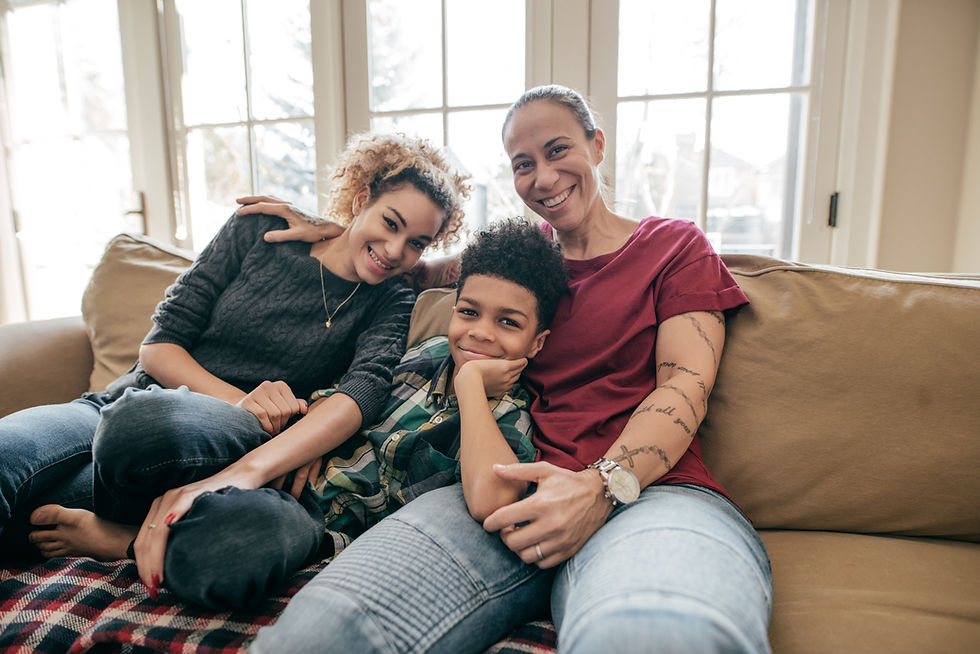Top Tips to Support Your Child with Social Anxiety
- drmorvwenduncan

- Jul 8, 2024
- 5 min read
Social anxiety can be a significant challenge for many children and young people, impacting their ability to enjoy time with their friends, participate in school activities, and enjoy everyday life. As a parent, your support and understanding can make a world of difference. Here are some top tips to help you support your child in overcoming social anxiety, informed by Cognitive Behaviour Therapy and written by a Clinical Psychologist at The Lotus Psychology Practice.
What is Social Anxiety Disorder?

Social Anxiety Disorder is relatively common, affecting 4.7% children, 8.3% adolescents and 17% of young people generally. Social anxiety disorder is characterised by marked and excessive fear or anxiety that consistently occurs in one or more social situations such as social interactions (e.g. having a conversation with a peer), doing something while feeling observed (e.g. eating or drinking around others), or performing
in front of others (e.g. giving a speech or ordering in a restaurant). This can lead to worries that the young person will act in a way that will be judged negatively by others or that they will show physical symptoms of anxiety, such as "others will notice I will blush or sweat". Young people with social anxiety understandably begin to avoid social situations, which helps reduce the anxiety in the short term. However, over time, avoidance feeds the anxiety as the young person never learns that nothing bad happens, or that they can manage. Your child may struggle to say hello to peers, teachers or participate in lessons. Without appropriate intervention, social anxiety can have a negative impact on a young persons emotional, social and educational development.
Tip 1: Learn about Anxiety
An important first step in overcoming anxiety and managing the physical symptoms is to understand why we feel sickness in our stomach, or our heart races. Anxiety is a self-protective system designed to help us survive. We need our anxiety system: when we’re crossing the street and we sense a speeding car approaching, our anxiety system gets us out of the way and to safety. In our brain, an area called the amygdala sets off an alarm system in response to perceived danger. The Fight, Flight, Freeze response is our body's call to action, and when activated, our brain diverts blood and oxygen to our muscles to help us evade danger quickly. This response leads to the symptoms of anxiety: hyperventilating, which makes sure we get oxygen into our blood stream, pulse racing, which makes sure the blood gets around our body quickly, and butterflies or nausea as our body diverts blood away from digestion.
In social anxiety, the brain sets off a false alarm to any perceived danger in social settings. It is important to recognise our brain’s false alarms, to understand that we are not in danger. The next task is to recalibrate our false alarm system.
Tip 2: Externalise the Anxiety
Anxiety can be seen as a bully that bosses your child around, this may be telling your child that other people will stare at them or laugh at them. Anxiety can become internalised and impact on children’s confidence and self-esteem. Naming and externalising the anxiety separates the anxiety from the child. You can do this with your child by naming and drawing the anxiety monster. You can explore how they make your child's body feel, what thoughts they bring up and what they make the young person do (or stop doing). You can then devise a plan together to overcoming the anxiety monster.
Tip 3: Graded Exposure
Gradual exposure, a key CBT technique, involves slowly facing feared social situations in a controlled and systematic way.
Create a Hierarchy: Work with your child to create a list of social situations that cause anxiety, ranked from least to most intimidating.
Step-by-Step Approach: Start with the least anxiety-provoking situation and gradually work up the hierarchy. Encourage your child to stay in each situation until their anxiety decreases.
If your child is younger, you may want to draw out the hierarchy as a ladder, At the bottom of the ladder, think of easier fears to face, and gradually work up the steps, increasing in difficulty as you go. Some examples may be putting their hand up in class or asking a stranger for directions. It is important that those fears are confronted gradually, with lots of praise and encouragement given at every stage!
You may think with your child about small rewards for each step to help motivate them when their anxiety kicks in.
Tip 4: Anxiety Tools
Equip your child with tools to add to their toolbox to manage their anxiety in stressful situations. You may want to draw out a personalised tool box with your child, and explore how different strategies work for them, before adding a 'tool' to the tool box:

Deep Breathing: Teach them deep breathing exercises to calm their nerves. You can find many videos on youtube of 'square breathing'.
Mindfulness: Encourage mindfulness practices to help them stay present and reduce anxiety. In particular, many young people find progressive muscle relaxation, or 'leaves on a stream' helpful (again youtube is your friend!)
Distraction: a great way to take your mind away from anxious thoughts is to use distraction. The 5,4,3,2,1 technique is a great way to distract the brain using the sense. You notice 5 things you can see, 4 things you can hear, 3 things you can feel, 2 things you can smell and 1 thing you can taste.
Role-Playing: Act out various social scenarios at home to build confidence and prepare your child for real-life situations.
‘Worry Time’. This can be 15 minutes at the end of the day where your child can share their worries with you. If a worry occurs during the day, they can be advised to write it down and save it for ‘worry time’. Some children benefit from a worry monster or a worry box where they can physically write the worry down and store it there. The worries can then be reviewed during worry time.
Tip 5: Model Positive Social Behaviour
Children often learn by observing their parents. If you avoid certain things that make you feel anxious, your child is observing and learning that anxiety=avoidance. Demonstrate positive social interactions and coping strategies.
Share Your Experiences: Talk about times when you felt anxious and how you coped with it.
Reduce Reassurance: In order for your child to develop coping skills to face anxiety independently they will require a reduction in parental reassurance and encouragement to be ‘brave’. This should be explained with your child and done in collaboration as a family in ‘fighting the anxiety bully’.
Tip 6: Socialise!
Provide opportunities for your child to interact with peers in a structured and supportive setting.
Small Groups: Start with smaller, more manageable groups before progressing to larger gatherings.
Extracurricular Activities: Encourage participation in clubs or activities that interest them, as shared interests can make socialising easier.
Professional Help
The National Institute for Health and Clinical Excellence provide clinical guidelines, based on the best research evidence. NICE guidelines recommend an assessment and intervention, such as cognitive behavioural therapy for children and young people exhibiting symptoms described above. This should be adapted for your child's age and any neurodiversity if relevant. At The Lotus Psychology Practice, we are experienced in assessing and providing evidence-based psychological therapy for children and young people experiencing social anxiety. Please get in touch if you would like to hear more about how we can help.



Comments